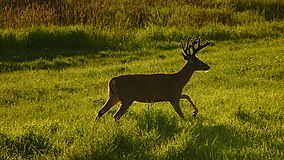Julia Butler Hansen Refuge for the Columbian White-Tailed Deer
| Julia Butler Hansen Refuge for the Columbian White-Tailed Deer | |
|---|---|
IUCN category IV (habitat/species management area) | |
 | |
| Location | Clatsop, Columbia counties, Oregon, Wahkiakum County, Washington, United States |
| Nearest city | Cathlamet, Washington |
| Coordinates | 46°14′50″N 123°24′49″W / 46.24722°N 123.41361°W |
| Area | 5,600 acres (23 km2) |
| Established | 1972 |
| Named for | Julia Butler Hansen |
| Governing body | U.S. Fish and Wildlife Service |
| Website | Julia Butler Hansen Refuge |
Located in southwestern Washington and northwestern Oregon, United States, the Julia Butler Hansen Refuge for the Columbian White-Tailed Deer is a wildlife refuge. It was established in 1972 specifically to protect and manage the endangered Columbian white-tailed deer. The refuge contains over 5,600 acres (23 km2) of pastures, forested tidal swamps, brushy woodlots, marshes, and sloughs along the Columbia River in both Washington and Oregon.
Etymology and history
[edit]The refuge is named for Julia Butler Hansen, a former member of the United States House of Representatives for Washington state. Originally named the Columbian White-Tailed Deer Refuge, the name was changed in 1990.[1]
The refuge was specifically created to provide a protected habitat for endangered Columbian white-tailed deer. By 2015, the deer population in the Lower Columbia River region, which includes Julia Butler Hansen and the Ridgefield National Wildlife Refuge, had doubled to 900, allowing the species to receive a recommendation to be reclassified as threatened.[2] In April, 2012, a dike that keeps the Columbia River from flooding the Julia Butler Hansen Refuge collapsed during high river flow levels. The potential flood was considered a threat to the resident population of Columbian white-tailed deer.[3] A large portion of the deer population at the Ridgefield site is due to a relocation of deer from Julia Butler Hansen during the flood concerns.[2]
Habitat
[edit]
The valuable habitat the refuge preserves for the deer also benefits a large variety of wintering birds, a small herd of Roosevelt elk, river otter, various reptiles and amphibians including painted turtles and red-legged frogs, and several pairs of nesting bald eagles and osprey.
Approximately 300 Columbian white-tailed deer live on the refuge per the last count. Another 300-400 deer live on private lands along the river. The areas upstream from the refuge on Puget Island and on the Oregon side of the river are vital to reestablishing and maintaining viable populations of the species. The refuge works with private and corporate landowners to maintain and reestablish deer on their lands.
References
[edit]- ^ Department of the Interior and Related Agencies Appropriations for 1991. Department of the Interior and Related Agencies Appropriations for 1991: Hearings Before a Subcommittee of the Committee on Appropriations, House of Representatives, One Hundred First Congress, Second Session. U.S. Government Printing Office. 1990. p. 648. Retrieved July 11, 2024.
- ^ a b Florip, Eric (October 19, 2015). "Success story: White-tailed-deer population rebounds". The Seattle Times. The Columbian. Retrieved September 26, 2024.
- ^ St. John, Natalie (April 5, 2012). "Looming dike collapse threatens Cathlamet deer refuge". The Daily News (Longview, Washington). Retrieved April 5, 2012.
![]() This article incorporates public domain material from websites or documents of the United States Fish and Wildlife Service.
This article incorporates public domain material from websites or documents of the United States Fish and Wildlife Service.
- IUCN Category IV
- National Wildlife Refuges in Washington (state)
- National Wildlife Refuges in Oregon
- Protected areas of Wahkiakum County, Washington
- Protected areas of Columbia County, Oregon
- Protected areas of Clatsop County, Oregon
- Protected areas established in 1972
- 1972 establishments in Oregon
- Wetlands of Oregon
- Wetlands of Washington (state)
- Landforms of Wahkiakum County, Washington
- Landforms of Columbia County, Oregon
- Landforms of Clatsop County, Oregon


